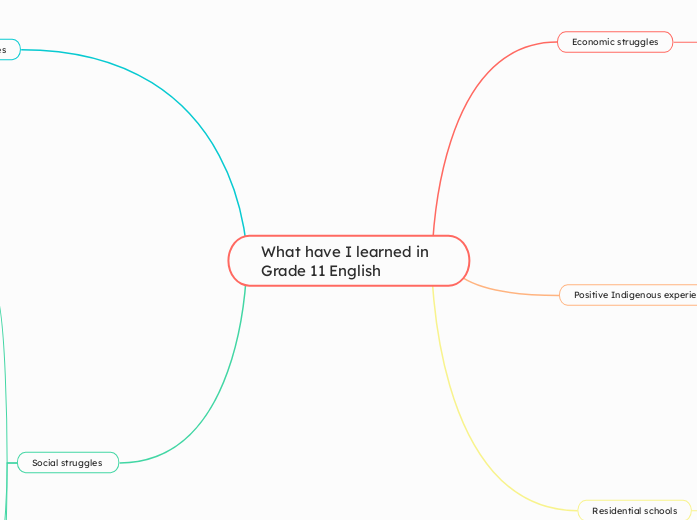arabera Jessica Bercovitch 1 year ago
133
What have I learned in Grade 11 English

arabera Jessica Bercovitch 1 year ago
133

Honelako gehiago
Text to text: Through shows like First Contact, it deconstructs these said stereotypes by sharing an authentic experience on why they may been see this way. I can recall during one specific scene, it explained how Indigenous communities are struggling to accept health, as to healthcare facilities-- they are just another patient. However, this doesn't disregard that Indigenous communities want help, but after generations of abuse, it is hard to unlearn unhealthy coping mechanisms and reach out. Additionally, this show highlighted how Indigenous people are not stealing tax dollars, they owe money from the treaty when colonizers came to Canada. They formed an agreement that Indigenous would get 50% of Canada's resources, which has not be reconciled. Canada is in debt to Indigenous people.
In our class, we thoroughly discussed the topic of MMIW in Canada. We were taught the tragic, untold stories of many missing women and girls. The reason behind the violence is a deeply rooted problem caused by many different factors. The main problem is due to sexist stereotypes, which influence the perpetrator to believe that they can get away with the harmful acts that they commit. The sexism they face is due to the fact that women are looked at as "weak" and "unable to stand up for themselves," making them an easy target, despite these stereotypes being true.
Text to world: Sexism is not just limited to Indigenous communities, it is seen all around the world, in every country. A current example of this is unfortunately shown in modern America. On June 24, 2022, the U.S. Supreme Court abandoned its duty to protect fundamental rights and overturned Roe v. Wade, stating that abortion is not a federal constitutional right. From that point on, 13 states in America have banned abortion. This heartbreaking news banishes women from the right to decide if they want a child or not. It disregards many factors, such as forced pregnancies from sexual assault, accidental pregnancies, and other reasons not to want a child. This law was reversed due to religious reasons and personal opinions, however, it should only be up to the individual themselves to decide. This relates to Indigenous women as women are not seen to the same importance as men. In both circumstances, women are stripped of their own rights, and don't have a say in what they want done to their bodies.
Text to text: In the book Indian Horse, the main character Saul Indian Horse gets forcefully placed in St. Jeromes Indian Residential school. In St. Germs, Saul quickly learned that the school was not place for education, rather for assimilation. He was taught to not speak his own language, and express any type of belief for his own cultural roots. He had to hide his identity, and had no freedom to express himself and show emotions-- or he would be punished.
Text to world: A similar story of residential schools is shown with the Holocaust. Both of these tragic events are due to the fact that a group did not agree with their cultural ways and wanted to get rid of them and/or assimilate them into their society. They displaced Indigenous or Jewish communities from their homes and made them work for free labour. Similarly, both minorities were extremely mistreated in the facilities they occupied; these groups were viewed as Jews or "Indians" rather than actual people.
Intergenerational trauma
Powwows are a highly important cultural and social gathering for Indigenous people. Through the act of the powwow, many FNMI individuals express their heritage through dance. It is a joyful celebration of music and culture, bringing Indigenous communities together. During powwows, many Indigenous folk will be seen playing a cultural drum alongside dancers wearing ethnic attire and performing cultural dances.
Text to self: My Bat Mitzvah. As a person of Jewish heritage, at the age of 12, I had a bat mitzvah. A bat mitzvah is a cultural celebration of transitioning from a young girl to a woman. This event is spent with a large gathering of people and involves performing cultural dances such as the hora. This leads to a connection between both celebrations by performing ethnic dances as a way to express heritage.
The water crisis is an ongoing issue prominent in Indigenous communities. Many Indigenous communities do not have access to clean and safe drinking water. Most FNMI reserves in Canada have one of the three types of water advisories as follows: do not use, do not consume, and boil water. The reason for the water advisories is brought about by the government's lack of financial support. In addition to finanical issues, a lack of source water safeguards and government support for private water and wastewater systems contributes to the crisis on reserves. Water should be a fundamental right for all, and it is very heartbreaking that many Indigenous reserves do not have clean water.